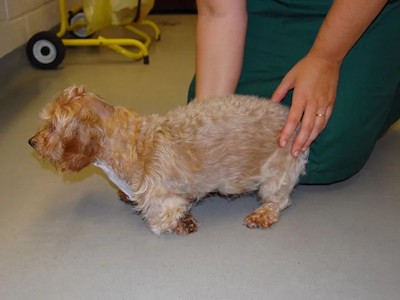Dogs who have trouble with balance or coordination are said to have ataxia. Their posture, gait, and motions may be affected, causing them to trip, fall, or walk in circles. Numerous conditions that impact the neurological system, including infections, trauma, toxins, and genetic disorders can result in ataxia.

Since it may be a sign of an underlying illness or injury that needs to be treated, ataxia can be a serious condition that needs rapid veterinary care. This article will define ataxia and discuss how it affects canines as well as its causes, symptoms, treatment options, and prevention.
Table of Contents
Types of Ataxia in Dogs
Ataxia can be classified into three types based on the part of the nervous system that is affected: cerebellar, vestibular, and proprioceptive.

Cerebellar ataxia
Cerebellar ataxia affects the cerebellum, which is the part of the brain that controls voluntary movements and coordination. Dogs with cerebellar ataxia may have tremors, jerky movements, exaggerated steps, head tilting, or difficulty standing or walking.
Vestibular ataxia
Vestibular ataxia affects the vestibular system, which is the area of the inner ear and brain that controls balance and direction. Vestibular ataxia in dogs may lead to vertigo, nausea, vomiting, nystagmus (rapid eye movements), as well as trouble hearing or seeing.
Proprioceptive ataxia
Proprioceptive ataxia affects the proprioceptive system, which is the part of the spinal cord and peripheral nerves that provides feedback on the position and movement of the limbs and body.
Dogs with proprioceptive ataxia[1] may have weakness, paralysis, knuckling (walking on the top of the paw), crossing over (placing one limb over another), or difficulty sensing where their limbs are.
Causes of Ataxia in Dogs
Ataxia can be caused by various factors that damage or interfere with the nervous system. Some of the common causes of ataxia in dogs are :

Infections
Infections caused by bacteria, viruses, fungi, or parasites can harm the brain, spinal cord, or inner ear and result in inflammation or abscesses that interfere with the nervous system’s ability to function.
Rabies, distemper, Lyme disease, Rocky Mountain spotted fever, ehrlichiosis, leptospirosis, toxoplasmosis, neosporosis, cryptococcosis, and ear infections are a few examples of infectious diseases that can produce ataxia.
Injuries
Trauma to the head, neck, spine, or inner ear can cause bleeding, swelling, or compression of the nervous tissue and result in ataxia. Some examples of injuries that can cause ataxia are car accidents, falls, bites, gunshot wounds, or spinal cord diseases such as intervertebral disc disease or degenerative myelopathy.
Toxins
Ataxia can be brought on by some chemicals having an impact on the neurological system. Lead, mercury, arsenic, antifreeze, rat poison, chocolate, alcohol, marijuana, and some drugs like metronidazole and ivermectin are a few examples of toxins that can produce ataxia.
Genetic disorders
Ataxia can be inherited in some dog breeds because of disorders that impair the neurological system. Cerebellar abiotrophy, hypoplasia, vestibular syndrome, wobbler syndrome, and degenerative cerebellar ataxia are a few examples of hereditary conditions that can result in ataxia.
Symptoms of Ataxia in Dogs
The symptoms of ataxia in dogs may vary depending on the type and severity of the condition. However, some common signs that indicate a loss of balance or coordination are:
- Stumbling
- Falling
- Walking in circles
- Tilting the head
- Swinging the head from side to side
- Rolling over
- Difficulty standing up
- Difficulty walking
- Difficulty turning
- Difficulty jumping
- Difficulty climbing stairs
- Difficulty eating or drinking
- Drooling
- Nausea
- Vomiting
- Rapid eye movements
- Difficulty hearing
- Difficulty seeing
- Tremors
- Jerky movements
- Exaggerated steps
- Weakness
- Paralysis
- Knuckling
- Crossing over
Diagnosis of Ataxia in Dogs

The vet will do a physical examination[2], and inquire about your dog’s medical history, symptoms, and possible exposure to any illnesses, traumas, poisons, or genetic abnormalities in order to diagnose ataxia in dogs.
To figure out the kind and cause of ataxia, the vet may also carry out certain tests and procedures, such as:
- Blood tests: To look for any indications of anemia, infection, inflammation, or bleeding issues.
- Urine tests: To look for any indications of diabetes, intoxication, or kidney issues.
- X-rays: To look for any indications of fractures, tumors, or disorders of the spinal cord.
- MRI or CT scan: To look for any indications of abnormalities in the brain or spinal cord, such as swelling, infections, bleeding, or tumors.
- CSF analysis: To examine the cerebrospinal fluid, which surrounds the brain and spinal cord, for any indications of infection or inflammation.
- Examination of the ears: To look for any indications of ear infections or inner ear issues.
- Neurological exam: To figure out reflexes, sensation, vision, hearing, and coordination for any indications of nerve injury or malfunction.
- Genetic testing: To look for any indications of inherited nerve system problems.
Treatment of Ataxia in Dogs
The treatment of ataxia in dogs depends on the cause and type of the condition. Some of the possible treatments are:

Medications
Your vet may prescribe antibiotics, antifungals, antiparasitics, anti-inflammatories, steroids, anticonvulsants, painkillers, or vitamin K to treat the underlying infection, inflammation, seizure, pain, or bleeding disorder that causes ataxia.
Your vet may also advise you to stop giving your dog any medications or supplements that may have caused ataxia as a side effect.
Surgery
Your vet may perform surgery to remove any tumors, abscesses, or foreign bodies that cause ataxia. Your vet may also perform surgery to decompress or stabilize the spinal cord if it is affected by trauma or disease.
Supportive care
To assist your dog in coping with the ataxia symptoms, the vet might provide supportive treatment. Fluids, food, oxygen treatment, physical therapy, massage, acupuncture, or hydrotherapy could all be part of this.
The vet might also recommend making some changes to the structure of your home, such as adding ramps, matting, harnesses, or carts to improve your dog’s comfort and mobility.
As mentioned by Dr. Brittany Kleszynski DVM in petmd, "Dogs recovering from ataxia should have a safe, comfortable space at home to rest. Care must be taken to keep the dog away from any stairs or potentially dangerous objects. Recovering dogs may need help with potty breaks and meals."
Prevention of Ataxia in Dogs
While some cases of ataxia in dogs may not be preventable, there are some steps you can take to reduce the risk of balance problems in your dog, such as:
- Vaccinate your dog against major infectious diseases like rabies, distemper, Lyme disease, and Rocky Mountain spotted fever which can result in ataxia.
- Protect your dog from parasites that can cause ataxia, such as ticks, fleas, worms, or protozoa. Use appropriate preventive products and check your dog regularly for any signs of infestation.
- Avoid exposing your dog to toxins that can cause ataxia, such as lead, mercury, arsenic, antifreeze, rat poison, chocolate, alcohol, marijuana, or certain medications. Keep these substances out of your dog’s reach and dispose of them safely. If you suspect your dog has ingested any of these substances, contact your vet immediately.
- Keep a watch for any signs of injuries to the head, neck, spine, or inner ear in your dog that could result in ataxia. If your dog has experienced any of the following: an accident, a fall, a bite, a gunshot wound, or symptoms of spinal cord disease, get veterinarian care.
- If you wish to get a purebred dog that is prone to hereditary conditions that can result in ataxia, pick a trustworthy breeder. Request the parent’s and the puppy’s health records and the results of any genetic tests. Avoid breeding dogs with these illnesses or those who carry them.
- Provide your dog with a balanced diet that meets its nutritional needs and prevents deficiencies or excesses that can affect the nervous system. Consult your vet for the best diet for your dog’s age, breed, size, and health condition.
- Provide your dog with regular exercise that keeps it fit and healthy and prevents obesity or muscle loss that can affect its balance and coordination. Avoid overexerting your dog or exposing it to extreme temperatures or altitudes that can stress its nervous system.
- Provide your dog with regular check-ups and preventive care that can detect and treat any health problems that can cause ataxia. Follow your vet’s recommendations for vaccinations, deworming, dental care, and screening tests.
FAQs
What should I do if my dog shows signs of ataxia?
If you notice your dog exhibiting signs of ataxia or any neurological abnormalities, it’s essential to consult with a veterinarian promptly. Early diagnosis and intervention can improve the prognosis and quality of life for your canine companion.
Can ataxia in dogs improve or resolve with treatment?
Yes, some cases of ataxia can improve or resolve with appropriate treatment. However, the outcome varies depending on the cause, and some forms of ataxia may be chronic or progressive.
Can ataxia in dogs be hereditary?
Some forms of ataxia can have a genetic component and may be hereditary in certain breeds. Breed-specific genetic tests are available to identify predispositions to hereditary ataxias.
Can dietary changes help manage ataxia in dogs?
Dietary modifications may be recommended depending on the underlying cause of ataxia. For example, specific diets may be beneficial for dogs with metabolic or nutritional disorders. Consult your veterinarian for guidance on appropriate dietary changes.
Can ataxia in dogs be contagious to other pets or humans?
Ataxia itself is not contagious. It is a symptom of an underlying condition, and the cause of the condition (such as an infection or toxin) may or may not be contagious. It is essential to identify and treat the underlying cause to prevent potential transmission to other pets or humans.
Conclusion
Ataxia is a complex neurological symptom that can arise from various underlying causes. It is not a condition to be taken lightly, and a prompt and accurate diagnosis is crucial. With the right care and support, many dogs with ataxia can lead fulfilling lives, and their resilience serves as a testament to the strong bond between humans and their beloved canine companions.
Reference:
- Types of ataxia. (n.d.). Department of Neurology | the University of Chicago.
- Physical Examination AIDS Pet Wellness – Veterinary Medicine at Illinois. (2018, March 26). Veterinary Medicine at Illinois.


